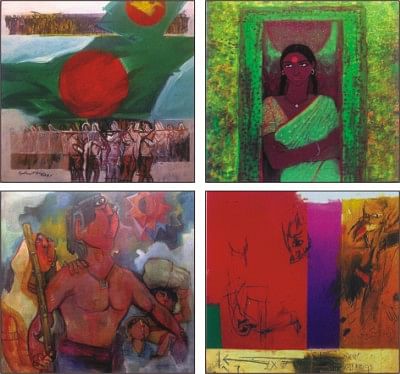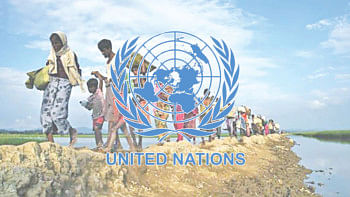Liberation War in art

(Clockwise from top left): Artworks by Syed Enayet Hossain, Nasreen Begum, Nisar Hossain and Nurul Islam on display.
On the occasion of Martyred Intellectuals' Day and Victory Day, Bangladesh Shilpakala Academy (BSA) organised a group art exhibition. The exhibition features works -- in different mediums -- of 26 painters. On display are works of senior and prominent painters like Mohammad Kibria, Syed Jahangir, Syed Enayet Hossain, Nitun Kundu, Samarjit Roy Chowdhury, Nurul Islam, Hamiduzzaman Khan, Abdus Sattar, Nisar Hossain, Debasish Pal and others. The exhibition is now on at National Art Gallery of BSA.
Nitun Kundu, one of the leading modern sculptors of Bangladesh, has to his credit “Sabash Bangladesh” on Rajshahi University campus -- a glorious tribute to the Liberation War. He graduated from the Government Institute of Arts (now Faculty of Fine Arts, University of Dhaka). During that time there was no sculpture department at the institution. He was a student of the painting department. He gradually developed his skills in the sculpture medium. His “Shaheed Sharoney”, in bronze, is a symbol of gun.
Syed Jahangir likes to portray the scenic beauty of rural Bengal. In his work, ammunitions of Freedom Fighters are prominent. Jahangir mostly works in oil, water and acrylic mediums; oil being his favourite.
Samarjit Roy Chowdhury is one of the prominent figures in the Bangladeshi art circuit. He is particularly known for the folk motifs in his works. In his work at the exhibition, a female visage with some folk motifs delineate familiar aspects of Bengali culture. Acrylic, pastel, oil and mixed media are predominately used in his large and medium canvases. Restless curves, geometric forms and broken lines make his paintings noteworthy.
Syed Enayet Hossain is another significant painter of the late '60s. His work “Jai Bangla” shows a group of people celebrating victory under a large national flag. Red and green are very significant and the figure movements are noticeable in the painting.
Nasreen Begum achieved fame for her series on “Cactus”. In recent times, she has been working on other themes but maintains her individual language. Scrupulous technique and smooth shades are the prime characteristics of her works. At the exhibition, her painting shows a rural woman waiting for her beloved. Her face appears gloomy and the eyes are the most noticeable feature in the work.
Nisar Hossain is a socially aware painter who tries to capture varied personal relationships, socio-economic and political dilemmas. Gruesome faces in different perspectives are common features in his paintings. Bright colours with sketch oriented human figures and varied animal forms are also recurring features. His “Ghatok 71”, shows some evil faces with vivid colours like red, mauve and light yellow.
Debashis Pal is another participant at the exhibition. He is an assistant professor at the Ceramic Department, Faculty of Fine Arts. His works delve deep into our rural culture, heritage and the Liberation War.
Nazib Mohammad is another participant at the exhibition. He does figurative paintings -- featuring rural men, lush greens, romantic images, birds, indigenous flora, people at leisure etc. His landscapes take the viewers far away from the hustle bustle of city life.
Freedom Fighters, the Liberation War and human forms in motion are the recurring themes in painter Shahabuddin Ahmed's artworks. His works focus on the strength and morale of the people of Bengal. His canvas is not tranquil. His painting at the exhibition shows a Freedom Fighter's courageous movement towards an unknown destination.
The exhibition continues till December 22.

 For all latest news, follow The Daily Star's Google News channel.
For all latest news, follow The Daily Star's Google News channel. 



Comments